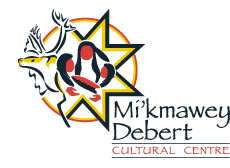Mi'kmawey Debert Cultural Centre Trivia
Congratulations - you have completed Mi'kmawey Debert Cultural Centre Trivia.
You scored %%SCORE%% out of %%TOTAL%%.
Your performance has been rated as %%RATING%%
Your answers are highlighted below.
Question 1 |
If someone gave you an “a’kwesn,” you would put it:
On your head | |
In your mouth | |
On your foot |
Question 1 Explanation:
Don’t eat your hat.
Question 2 |
Mi’kmaw traditional art comes in two popular forms. These are:
Wooden or copper totems | |
Soapstone carving and bone or tusk jewelry | |
Porcupine quill embroidery and basket-weaving |
Question 2 Explanation:
Porcupine quill embroidery and basket-weaving.
Question 3 |
Eskasoni’s Lee Cremo gained international acclaim for playing which instrument?
Fiddle | |
Drums | |
Tin flute |
Question 3 Explanation:
The fiddle. Lee Cremo won “Best Bow are in the World”, at the World Fiddle Championship in Nashville, Tennessee.
Question 4 |
In the early and mid 20th Century the Indian Affairs developed introduced the Centralization policy for the Mi’kmaq in Nova Scotia. The policy included efforts to:
Move the Mi’kmaw population to two reserves | |
Deliver services to Indians from urban centers | |
Provide services from one central office |
Question 4 Explanation:
The aim of Centralization was to relocate the Mi’kmaq to two reserves, Eskasoni and Shubenacadie. Promises were made of new houses and work that were not kept.
Question 5 |
Before the arrival of European settlers, the Mi’kmaq called themselves:
Lentuk | |
Mi’kmaq | |
L’nuk |
Question 5 Explanation:
The Mi’kmaq referred to themselves as L’nuk, or the people. Settlers who learned the language called them “Mi’kmaq”, or kin-friends. Lentuk means deer.
Question 6 |
Mi’kmaw people were buried with clothes, food, and other items so:
The person’s belongings are not used by others | |
They could bring gifts to the Ghost World | |
The item’s spirits could join them |
Question 6 Explanation:
Men and women would be buried with everything they might need, including unfinished projects, so they would be well prepared in the Ghost World. This practice is continued by some Mi’kmaq today.
Question 7 |
A “matues” is an animal you should never:
Pat | |
Sniff | |
Stand in front of |
Question 7 Explanation:
Porcupines have sharp barbed quills, which can be painful and difficult if they get lodged in skin.
Question 8 |
The Supreme Court’s 1999 ruling, the Marshall Decision, recognized the Mi’kmaw right to a moderate living by means of:
Tourism | |
Fishing | |
Tobacco sales |
Question 8 Explanation:
Donald Marshall Jr., a Mi’kmaw, was pronounced not guilty of the charges of fishing in violation of federal fishery regulations, based on the court’s recognition of Mi’kmaw treaty rights.
Question 9 |
The Mi’kmaw game of waltes is a set of playing pieces, shaken in a bowl made of:
Stone | |
Antler | |
Wood |
Question 9 Explanation:
The bowl was hollowed out of a large burl, or knot, which grew on the trunks of large trees.
Question 10 |
A “leister” is a:
Snare used to catch rabbit and partridge | |
Birch bark megaphone for moose calls | |
Three pronged fishing spear |
Question 10 Explanation:
A “Leister” is an English term for a traditional fishing spear. All three answers are traditional tools of a Mi’kmaw hunter.
Once you are finished, click the button below. Any items you have not completed will be marked incorrect.
There are 10 questions to complete.
|
List |

 sharing our stories
sharing our stories